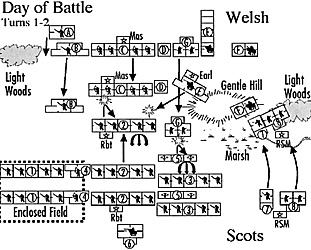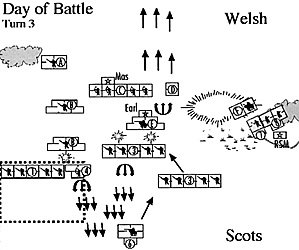The set up is identical to that in the Medieval Warfare playtest, except the Welsh Skirmishers have been pulled towards the middle of the line, leaving the Light Cavalry to fend for itself on the left, and the Levy Spearmen were stacked behind the regular Spearmen. Robert of St. Marks no longer has a bodyguard, the unit now incorporated into the block of Knights in reserve.
Once again, the Scottish Spear and Archers trudged through the fields, with two other spear units forming the main Line of Battle that spans the battlefield, from field to marsh. The standard was in the middle, and so was C-n-C Duke Robert of Scotland. The Crossbowmen marched in front a little. On the right, Robert of St. Marks advanced with the Men-At-Arms and Skirmishers to hold the stream line, if not push onward.
C-n-C Earl Palomir rested his right on the woods with Spear (with standard), backed by the Levy Spear. The Longbowmen were again in the middle, flanked by the Men-At-Arms. Skirmishers were placed next, and after them a column of Knights. The Light cavalry was all the way on the left.
 Turn 1:
Turn 1:
The Duke's forces shuffle forward with the idea of planting the line with the flanks protected by the field and the marsh. As before, a small covering force under the Hero Robert of St. Marks defends the far right flank, pushing hastily across the stream. The Crossbowmen advance out in front of the force.
The Earl's Light Cavalry head up the gentle hill and plant themselves firmly in the gap between woods and marsh. he himself was with the knights, who marched up in column and shook themselves out into combat formation. The rest of the Battle Line, with the Hero Mason of Llandor behind the Longbowmen, advanced.
DoB uses "Proximity Movement" in order for both sides to close quickly. If over 30 inches, units move triple movement, if between 15 and 30 inches, double movement, and if under 15 inches, normal movement. All is prorated when crossing these bands, so you speed up when moving away from enemy and slow down when coming closer. A Charge move is three times the basic movement rate (usually 6" for foot, 9" for knight cavalry, 15" skirmishers, and 30" for skirmisher cavalry) and ignores the bands! If you play on the suggested 4-foot by 4-foot size table, you're going to engage in combat VERY quickly.
The Welsh Skirmishers run ahead of the line, working down through the movement bands and toss a few javelins at the Crossbowmen. In DoB, missile fire is resolved by taking a base Combat Value, adding and subtracting modifiers (and halving for some instances), and rolling a d20 per stand (DoB calls a stand a "company") to see if you hit. If the unit has a special "Master Archer" attribute, it receives another d20. Total up the number of hits (called "strikes" in DoB parlance), and compare to the total number of stands in the target unit. If hits equal less than half, 1 figure on a stand is killed, if hits equal half the stands, 1 figure is killed and the unit is disordered. If hits equal more than half the stands, then 2 figures killed and check morale. When enough figures are killed, a stand is removed.
The Crossbowmen took the loss and morale check. Unlike most rule systems, you do NOT roll dice for DoB morale checks. It is the most difficult concept to learn in the game. Instead, you start with the unit's base Morale Grade, apply modifiers, and cross check the end result against the Morale Chart. Four consequences may result: Break (i.e. rout), Fail (pull a card and apply results from an "Morale Event Table"), Carry On (i.e. Pass), and Advance (attack nearest enemy unit!).
Sure enough, the Crossbowmen were goaded into charging the Welsh Skirmishers. Melee is similar to missile fire, in that you start with a Combat value, modify it,and come out with a number to beat for hits. Additioanlly, there is a "Weapon of Choice" hierarchy that gives a big bonus for those with the choicest weapon. If both sides use the same weapon, the Weapon of Choice modifier is not used.
The Skirmishers lost the melee, and in the subsequent morale check, routed off the table. However, with Earl Palomir still having CPs left, he ordered the Longbowmen to shaft the Crossbowmen, which then failed their morale test and fled off board. For the Welsh, an excellent trade!
Turn 2:
Over on the flank, the Welsh Light Cavalry fling some javelins at the Men-At-Arms, but to no avail as the stalwart Scotsmen pass the morale check.
The Welsh Longbowmen fired at the Scottish Spear in front of them, and inflicted enough casualties to cause a morale check—which, you guessed it, goaded the Spear to charge the Longbowmen. With the C-n-C attached, the spearmen screamed the battlecry and surged forward. The Longbowmen calmly fired again as the charge approaches (DoB has a "Rate of Fire" that allow bow- and javelin-armed units to fire multiple times in a turn), but the Spear passed morale. However, in the resulting melee, the Spear were repulsed.
When a leader is in melee, he must test his luck to see if he survives. Each leader has a Personal Combat Skill factor and tosses a d20. If below, he is safe. If above, he draws a card and compares it to a leader loss table. When the leader is attached to a unit that takes missile fire, he is safe unless he tosses a "20." In each case, Duke Robert of Scotland was safe.
However, Mason of Llandor was not. Attached to the Longbowmen and no doubt fighting from the front, he failed his PCS check! But wait! Each leader has a staff available, and sure enough, at the last moment, the sergeant attached to Mason stepped in front of the spearhead and died in his stead.
That's when Earl Palomir, leading from the front, ordered his Knights to lower lances and charge into the struggling mass of Spear. The melee was short and sweet, and the Scottish Spear routed, taking the C-N-C with them. In DoB, whenever a unit wins a melee against a unit carrying the Army banner, the victor draw a card to see if they capture the banner. If it is a face card, they do. In this instance, they did not.
During the melee, Earl Palomir and Duke Robert both failed their PCS check, but both also had faithful sergeants to impale themselves on lance and spear so the C-n-Cs could escape injury. Mason ordered up the Welsh Men-At-Arms and the regular Spear to support the Knights.
As Robert was being swept along by his fleeing Spear, he called out for the next Spear unit in the Battle Line to avenge this insult. That not being enough, he sent his Page (1CP) and Squire (1 more CP) to ensure they advanced. In they charged, catching the Knights at the halt. Earl Palomir, now more circumspect, passed his PCS check, but try as he might, could not stem the flood of fresh spearmen, and the Knights routed off the field, taking the Earl with them.
 Turn 3:
Turn 3:
The Welsh Longbowmen fired at the victorious Spear, inflicting some damage and forcing them to give ground. Then they charged them, damaging them heavily and routing the Scottish Spear off the battlefield. The regular Spear, proudly waving the Army banner, charged the Scottish Archers, which also rout off the table after damage and a morale check.
With 3 units out of 8 routed, the 1/3 mark was reached and the Scots retired from the battlefield. Here, we technically miscalculated the victory conditions, which occur when 1/3 of enemy stands ("companies"), not units, are eliminated. In retrospect, given the success of the Longbowmen versus Spear, we don't believe the outcome would change, although more carnage would result and there is always the chance than lucky dice could salvage a lost battle.
More Medieval Comparison
-
Long Bows and Short Knights: Introduction
Long Bows and Short Knights: Medieval Warfare
Long Bows and Short Knights: Day of Battle
Long Bows and Short Knights: Analysis and Conclusion
Other Medieval Rule Sets
Back to Table of Contents -- Courier #77
To Courier List of Issues
To MagWeb Master Magazine List
© Copyright 1999 by The Courier Publishing Company.
This article appears in MagWeb (Magazine Web) on the Internet World Wide Web.
Other military history articles and gaming articles are available at http://www.magweb.com